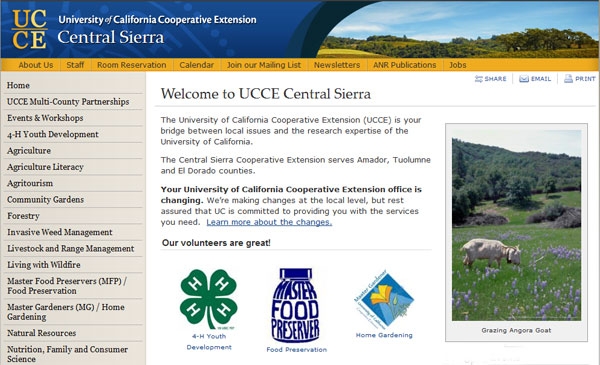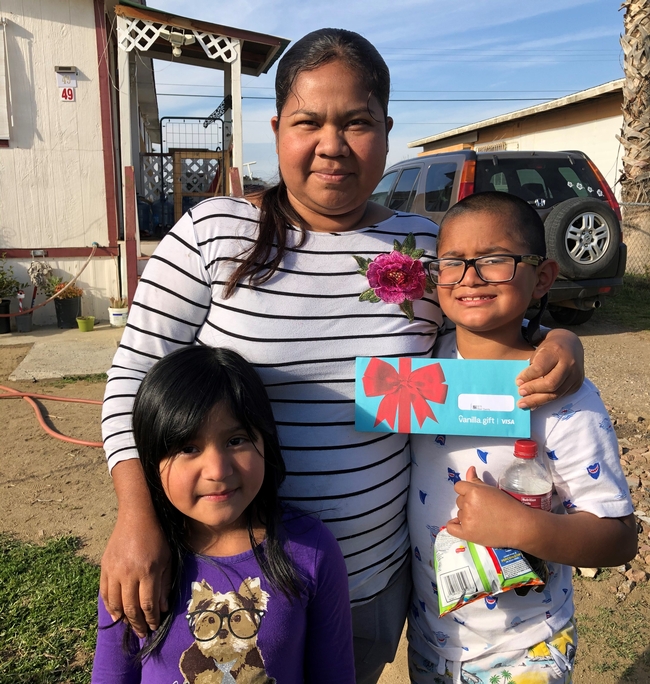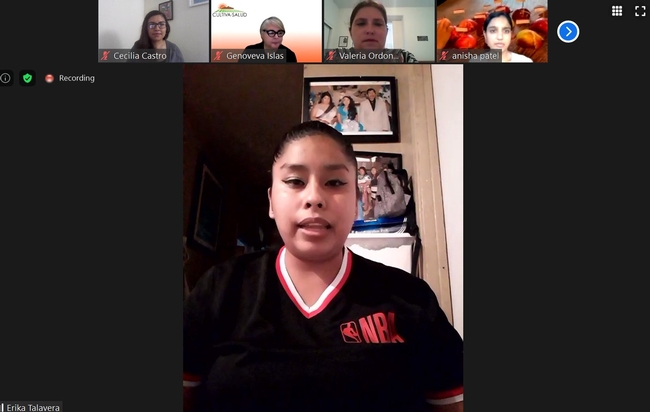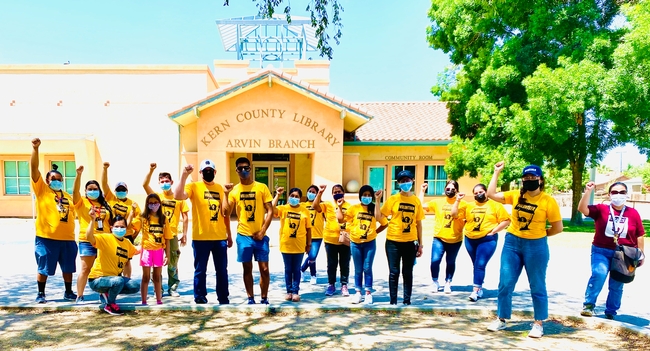Posts Tagged: partnership
No break for kids’ hunger: Partnerships help secure school meal programs
Partnering for California
As the gravity of the COVID-19 pandemic hit communities across the U.S. in mid-March 2020, the policy team at UC Agriculture and Natural Resources' Nutrition Policy Institute received an urgent email from a longtime partner in the San Joaquin Valley.
“It was simply entitled 'Help' in the subject line – with multiple exclamation points,” said Christina Hecht, NPI senior policy advisor.
The colleague was writing on behalf of community groups concerned that pandemic-related school closures would jeopardize school meal programs – a nutritional lifeline for children in a predominantly agricultural region with many low-income households.
Hecht immediately contacted a frequent collaborator, Anisha Patel, an associate professor of pediatrics at Stanford University. To help school districts continue those essential meals during the fast-approaching spring holiday, they quickly produced a fact sheet, “Kids' Hunger Doesn't Take a Spring Break,” sharing resources on how districts could use new program flexibility to continue meal distribution.
Then, as the pandemic evolved throughout 2020, the U.S. Department of Agriculture and California Department of Education continued to issue a flurry of waivers and guidance updates. To keep pace, the authors produced three more fact sheets to help districts digest the information and adapt and sustain their school meal programs.
“We tried to make a really user-friendly resource that would help districts sort through everything they needed to do, and easily discover resources for best practices,” Hecht said.
The fact sheet information, paired with advocacy by local partners, encouraged districts to take steps to make more meals more easily accessible to students by taking advantage of USDA waivers: for example, allowing parents to pick up meals without children present, providing multiple meals in one pick-up or implementing bus delivery of meals.
These efforts attracted the attention of the School Nutrition Association, a prominent nonprofit representing more than 50,000 members who provide meals to students across the country. The organization co-branded general versions of the fact sheets and distributed them widely through its website.
Gathering community perspectives on school meals
Those resources represent just one way that lessons from the San Joaquin Valley experience are shaping the national conversation on school nutrition programs. Cultiva La Salud and Dolores Huerta Foundation – health equity and social justice organizations based in Fresno and Bakersfield, respectively – approached the researchers to study ways to boost participation in school meal programs and address food insecurity in their largely Latino communities.
“Working alongside Stanford and NPI is crucial in expanding our capacity and ability to use data and research as a tool to empower parents to advocate for improved health and wellness policies and practices,” said Cecilia Castro, deputy director of Dolores Huerta Foundation, which works in Kern, Fresno and Tulare counties, as well as Antelope Valley in Los Angeles County.
To better understand the “barriers and facilitators” to meal program participation, Hecht, Patel and their collaborators – including student trainees who were eager to learn about community-based participatory research and wanted to help their local communities – sought the perspectives of school district administrators and staff, community groups and parents.
Through the relationships nurtured by Cultiva La Salud and Dolores Huerta Foundation, the researchers convened focus groups of parents with children in six school districts across the San Joaquin Valley.
“We needed to understand better what helped and hindered families from getting the school meals,” Hecht said.
According to Castro, parents have leveraged their feedback to advocate for increased access to school meals, through the use of buses for meal delivery and changes to meal pickup times and locations.
“This engagement has validated the lived experience of our communities,” Castro said. “It has provided an additional strategy for parent leaders to use in efforts to engage decision-makers about ways to improve quality and access to school meals.”
Another key takeaway from these conversations is that the parents are deeply concerned about the content and nutritive value of the meals served to their children.
“We learned that although school meals meet nutrition standards, parents are not aware of this,” Patel said. “Parents also worry about the healthfulness of school meals, noting heavy processing and added sugar. Most compelling was that parents want to provide feedback to improve school meal appeal and healthfulness but have no way to act.”
San Joaquin Valley voices go national
The Nutrition Policy Institute played a crucial role in bringing the parents' perspectives to legislative staff members at the state and federal levels, through the production of four policy briefs that center the voices of San Joaquin Valley residents. In the first, “School Meals: Kids Are Sweeter with Less Sugar,” one parent says: “Children cannot sustain themselves on treats that give pure sugar…They give with the best intentions, but less food would be better, but better quality and healthier.”
“One of the most rewarding parts of all this work has been seeing how meaningful it has been for the parents in the San Joaquin Valley to see their voices getting carried all the way to Washington, D.C. by these policy briefs,” said Hecht. “And it was so meaningful for them that Cultiva La Salud had the briefs translated into Spanish so that the parents could actually read their own words.”
Their voices joined a chorus comprising over 200 organizations who called for universal school meals across California. In June, the state became the first in the nation to adopt a policy, starting in the 2022-2023 school year, to provide free meals for all K through 12 public school students, regardless of family income. Momentum continues to build on the national scale.
The next step for the team is to explore ways to make school meals even more appealing to potential program participants in the Latino communities of San Joaquin Valley. Patel said they will draw on the expertise of Szu-chi Huang, associate professor of marketing in Stanford's Graduate School of Business.
“Using a participatory approach, we will work with parents and school officials to design an intervention focused on communicating the benefits of school meals, and test strategies to improve the appeal of school meals,” Patel explained. “Then we will examine how that intervention affects parents' satisfaction with school meals, students' participation in meals and food insecurity.”
Those insights will be another valuable result of a unique partnership – spurred by a call for help and galvanized by the ongoing health crisis – that continues to benefit families across California.
“Our partnership has been very unusual and very fruitful because we had policy experts, we had research experts and trainees, and then we had the organizations actually working in the community,” Hecht said. “And as we look back on it, it's hard to imagine working that successfully without that kind of partnership.”
Partnerships help secure, improve school meal programs in San Joaquin Valley
Partnering for California
As the gravity of the COVID-19 pandemic hit communities across the U.S. in mid-March 2020, the policy team at UC Agriculture and Natural Resources' Nutrition Policy Institute received an urgent email from a longtime partner in the San Joaquin Valley.
“It was simply entitled ‘help' in the subject line – with multiple exclamation points,” said Christina Hecht, NPI senior policy advisor.
The colleague was writing on behalf of community groups concerned that pandemic-related school closures would jeopardize school meal programs – a nutritional lifeline for children in a predominantly agricultural region with many low-income households.
Hecht immediately contacted a frequent collaborator, Dr. Anisha Patel, an associate professor of pediatrics at Stanford University. To help school districts continue those essential meals during the fast-approaching spring holiday, they quickly produced a fact sheet, “Kids' Hunger Doesn't Take a Spring Break,” sharing tips and resources for the districts.
Then, as the pandemic evolved throughout 2020, the U.S. Department of Agriculture and California Department of Education continued to issue a flurry of waivers and guidance updates. To keep pace, the authors produced three more fact sheets to help districts digest the information and adapt and sustain their school meal programs.
“We tried to make a really user-friendly resource that would help districts sort through everything they needed to do, and easily discover resources for best practices,” Hecht said.
Their efforts attracted the attention of the School Nutrition Association, a prominent nonprofit representing more than 50,000 members who provide meals to students across the country. The organization co-branded general versions of the fact sheets and distributed them widely through its website.
Gathering community perspectives on school meals
Those resources represent just one way that lessons from the San Joaquin Valley experience are shaping the national conversation on school nutrition programs. Cultiva La Salud and Dolores Huerta Foundation – health equity and social justice organizations based in Fresno and Bakersfield, respectively – approached the researchers to study ways to boost participation in school meal programs and address food insecurity in their largely Latino communities.
“Working alongside Stanford and NPI is crucial in expanding our capacity and ability to use data and research as a tool to empower parents to advocate for improved health and wellness policies and practices,” said Cecilia Castro, deputy director of Dolores Huerta Foundation, which works in Kern, Fresno and Tulare counties, as well as Antelope Valley in Los Angeles County.
To better understand the “barriers and facilitators” to meal program participation, Hecht, Patel and their collaborators – including student trainees who were eager to learn about community-based participatory research and wanted to help their local communities – sought the perspectives of school district administrators and staff, community groups and parents.
Through the relationships nurtured by Cultiva La Salud and Dolores Huerta Foundation, the researchers convened focus groups of parents with children in six school districts across the San Joaquin Valley.
“We needed to understand better what helped and hindered families from getting the school meals,” Hecht said.
According to Castro, parents have leveraged their feedback to advocate for increased access to school meals, through the use of buses for meal delivery and changes to meal pickup times and locations.
“This engagement has validated the lived experience of our communities,” Castro said. “It has provided an additional strategy for parent leaders to use in efforts to engage decision-makers about ways to improve quality and access to school meals.”
Another key takeaway from these conversations is that the parents are deeply concerned about the content and nutritive value of the meals served to their children.
“We learned that although school meals meet nutrition standards, parents are not aware of this,” Patel said. “Parents also worry about the healthfulness of school meals, noting heavy processing and added sugar. Most compelling was that parents want to provide feedback to improve school meal appeal and healthfulness but have no way to act.”
San Joaquin Valley voices reverberate
The Nutrition Policy Institute played a crucial role in bringing the parents' perspectives to legislative staffs at the state and federal levels, through the production of four policy briefs that center the voices of San Joaquin Valley residents. In the first, “School Meals: Kids Are Sweeter with Less Sugar,” one parent says: “Children cannot sustain themselves on treats that give pure sugar…They give with the best intentions, but less food would be better, but better quality and healthier.”
“One of the most rewarding parts of all this work has been seeing how meaningful it has been for the parents in the San Joaquin Valley to see their voices getting carried all the way to Washington, D.C. by these policy briefs,” said Hecht. “And it was so meaningful for them that Cultiva La Salud had the briefs translated into Spanish so that the parents could actually read their own words.”
Their voices joined a chorus comprising over 200 organizations who called for universal school meals across California. In June, the state became the first in the nation to adopt a policy, starting in the 2022-2023 school year, to provide free meals for all K through 12 public school students, regardless of family income. Momentum continues to build on the national scale.
The next step for the team is to explore ways to make school meals even more appealing to potential program participants in the Latino communities of San Joaquin Valley. Patel said they will draw on the expertise of Szu-chi Huang, associate professor of marketing in Stanford's Graduate School of Business.
“Using a participatory approach, we will work with parents and school officials to design an intervention focused on communicating the benefits of school meals, and test strategies to improve the appeal of school meals,” Patel explained. “Then we will examine how that intervention affects parents' satisfaction with school meals, students' participation in meals and food insecurity.”
Those insights will be another valuable result of a unique partnership – spurred by a call for help and galvanized by the ongoing health crisis – that continues to benefit families across California.
“Our partnership has been very unusual and very fruitful because we had policy experts, we had research experts and trainees, and then we had the organizations actually working in the community,” Hecht said. “And as we look back on it, it's hard to imagine working that successfully without that kind of partnership.”
Calaveras board to vote today on multi-county partnership
The Calaveras County Board of Supervisors convenes at 9 a.m. Tuesday, Aug. 23, according to The (Calaveras County) Pine Tree. Among the items on the agenda is a proposal to adopt a minute order authorizing the chair to sign the inter-local agreement between the Regents of the University of California Cooperative Extension, Amador County, Calaveras County, El Dorado County and Tuolumne County for the provision of the UCCE program to the multi-county partnership.
Also in the news today:
In the weeds of bureaucratic insanity there sprouts a small reprieve
Steve Lopez, The Los Angeles Times
A Los Angeles man who took UC Cooperative Extension classes to learn gardening techniques has been asked to remove the plants he is growing in a city-owned parkway, the area between the curb and the sidewalk. UC Master Gardener Florence Nishida has helped the urban farmer by digging up the city's residential parkway landscaping guideline and advocating on the farmer's behalf.
Bait beats spray in war on ants
Vincent Lazaneo, Sign On San Diego
You may be tempted to grab a can of aerosol bug spray when you enter your kitchen in the morning and see ants on the counter, but UC Cooperative Extension home horticulture advisor Vince Lazaneo says there are a number of safer alternatives. Wipe up ants with soapy water, plug holes to outdoors, and use bait stations to control ant populations.

CentralSierrapage


